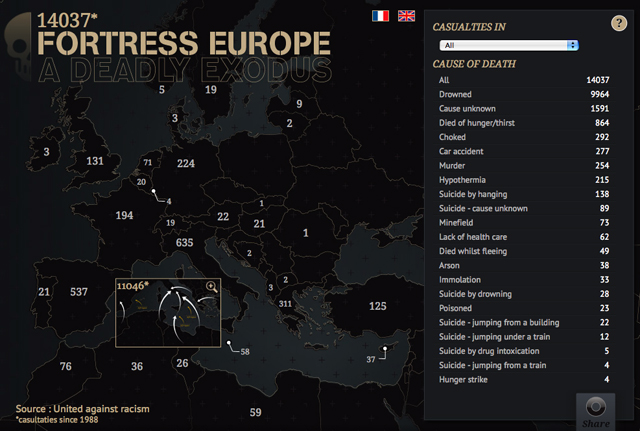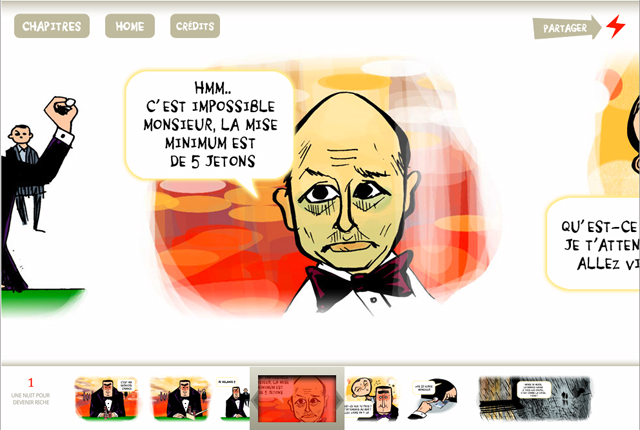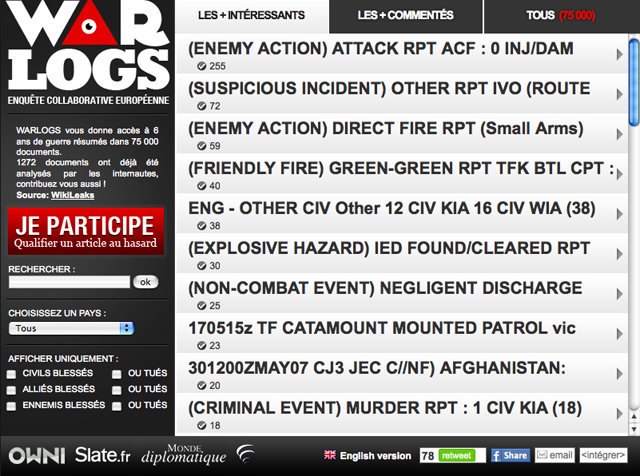How French Site OWNI Profits by Giving Away Its Content
A thoughtful analysis of who we are and what we do at OWNI, by Mark Glaser from PBS Mediashift.
[NDLR] OWNI.fr concourt aujourd’hui au festival South By SouthWest (SXSW), dans la catégorie “News Related Technologies” du SXSW Accelerator. L’occasion de mettre en avant quelques articles en anglais, proposés par les éditrices d’OWNI.eu Retrouvez ci-après une analyse de ce que fait OWNI, initialement publiée sur PBS Mediashift.
Most content sites in the U.S. have two ways of making money: charging for subscriptions or running advertising (or both). But a French site, OWNI.fr, has found an unusual business model for a site with no ads and no subscriptions — that’s also profitable. How do they do it? Their main business is doing web development and apps for media companies and institutions.
One big advantage for OWNI is its origins as a pure online business, with an entrepreneurial CEO Nicolas Voisin and a staff of web developers. The site was initially an aggregation of bloggers, with the parent company called 22Mars (March 22nd), set up to fight a controversial French copyright law known as HADOPI. While 22Mars was made up of web developers at launch in April 2009, they eventually revamped the site with more editorial direction and hired journalists in 2010 to work alongside the developers.
The result is a striking website, with an eye-catching design and various examples of data journalism and data visualization. In fact, when they set up an English-language site, OWNI.eu, its motto was “Digital Journalism.” The site won an Online Journalism Award at the ONA conference last year, and is a finalist in next week’s SXSW Accelerator competition for “news-related technologies.” Here’s a screen shot from one data visualization showing how many people have died immigrating to Europe from Africa:

All the American interest in the French site will grow exponentially when the site opens a U.S. subsidiary next month, somewhere in the San Francisco Bay Area. I spoke to the future CEO of that U.S. subsidiary, Adriano Farano, an Italian who had helped run Cafe Babel, a pan-European website. Here, he explains what the name OWNI means in French (largely a play on “UFO”):
Clip audio : Le lecteur Adobe Flash (version 9 ou plus) est nécessaire pour la lecture de ce clip audio. Téléchargez la dernière version ici. Vous devez aussi avoir JavaScript activé dans votre navigateur.
Farano told me that the parent company, 22Mars, is about a third of the way to closing a Series C round of funding for about 1.5 million Euros, and that they will seek a first round of funding for OWNI.us. In France, the company grew from just 8 people a year ago to 37 today, with 15 full-time journalists. At the same time, Farano says the site traffic also boomed, going from 200,000 monthly unique visitors to 1.5 million uniques today.
I also spoke by phone to OWNI’s director of data journalism, Nicolas Kayser-Bril. The following is an edited transcript of our international phone conversation.
Q&A with Nicolas Kayser-Bril
Nicolas Kayser-Bril: It wasn’t planned to be a media company at all. It was started in April 2009, where there was a law called HADOPI being passed in the French parliament, that was dangerous for online freedom [and later was the basis for Loppsi 2]. Several bloggers got together to set up a platform [to fight the law]. And the company that was set up to run OWNI is called 22Mars, and we decided to host the platform so we had a blog network hosted on a WordPress platform. Step by step, the platform grew, and Nicolas Voisin, the CEO of 22Mars decided to take the experiment further and put one person full-time on maintaining and engaging the community.
We saw that this worked well so we put more resources and people into OWNI. So we decided to become a real media [outlet], a real website, still with this strong community of bloggers behind it. In the summer of 2010, we realized that OWNI had become a real media [outlet], ran stories, and really had a big impact in the traditional media sphere. We hadn’t really planned to become one. This changed the way the company was organized. At first we had been more of a showroom for what we’re doing, and today it’s more of a lab where journalists are free to innovate and do what they want.
With that experience, we continue to run our service company, selling website development and applications. We specialize in providing apps and social media platforms. Half of our sales today have to do with social media, and the other half has to do with data visualization, crowdsourcing apps, and running innovative journalistic products. We serve all kinds of institutions and NGOs that have a story to tell but don’t know how to to do it online. We build the tools for them to do so.
Kayser-Bril: We do some social media consulting, but most of the work is building social media websites tailor made [for clients]. For instance, with universities, they have unique problems as to how to communicate between teachers and students and the wider public. So we built the interface using WordPress to solve this problem. So we always build custom solutions with added value.
Kayser-Bril: Nicolas, our CEO, was an entrepreneur and got into the media in 2006 before the presidential election in France. He started doing a political show; he realized there was a big gap on how the public was informed about candidates’ platforms. So what he decided to do was interview them without time limits and spent hours with them, and then posted them on YouTube. It worked really well, so he thought there was a need to reinvent storytelling online. That’s what drove him.
The other core people at the company are mostly developers. I myself have a background in economics. I never studied journalism. Before OWNI, I was living in Berlin and working at a startup. Before that I was doing freelance work. I was doing online work for a presidential campaign in 2009, mostly web-related things. We didn’t hire a traditional journalist until February 2010. Now we have many seasoned journalists working for us.
Kayser-Bril: 22Mars is for-profit, and we did not spin off OWNI as a non-profit organization from an accounting perspective. The website does not have to make a profit in the sense that we don’t make money from the website. No subscriptions and no hidden advertisements. The value the website provides is in gaining expertise online that we can then share and sell to clients.
Kayser-Bril: Exactly. You could compare it to businesses in other industries. We might start selling online objects or other products in the coming months to have more high-margin products.
We will start selling e-books, which is a big driving force of 22Mars — we don’t sell content but we sell products, because everyone knows content is abundant. What’s missing is a way to properly browse through it and consume it. So we’ll be selling apps. Not apps for the iPhone or in the App Store. We always remain on the HTML side and JavaScript and stay compatible with all platforms. So they would run on the open web as well as on the iPhone and iPad.
We’re convinced that the apps you see on the iPhone and iPad and Android in the future will be merged into web apps because it makes more sense economically to develop something once instead of three or four times. We develop for all devices. We recently published what we call an augmented cartoon where you have more depth in text, and can follow links. We made it for the iPad; it was more of an iPad app than it worked on a computer. With HTML 5 you can really design an app and optimize it for the device you want.
Kayser-Bril explains how developers will work for OWNI for less money than at other companies because they have a chance to work on projects about society and politics:
Clip audio : Le lecteur Adobe Flash (version 9 ou plus) est nécessaire pour la lecture de ce clip audio. Téléchargez la dernière version ici. Vous devez aussi avoir JavaScript activé dans votre navigateur.
Kayser-Bril: Not really, we’re not really involved in politics. What we do fight for is freedom online and offline, supporting the declaration of human rights. We could lead fights in defense of Internet freedoms (for example, against censorship, for Net neutrality, etc.). We’ll fight against all laws that restrict freedom of speech online. We don’t have any more political views beyond that. When you see the political views of people at OWNI, it ranges from leftist to libertarian so it would be impossible to have a single political line.
Kayser-Bril: WikiLeaks called us to do similar work that we are doing on a daily basis, which is building interfaces and web apps. Their problem is that they had masses of web documents but they were not comprehensible for a normal human being. So we came up with this app to browse through the Afghan War Logs. It illustrates how OWNI works, because when the Afghan War Logs came out, we realized we could build that just like for the Iraq War Logs.
It was a non-commercial relationship with WikiLeaks, and it made perfect sense because we learned a lot so we could sell crowdsourcing applications. From a business perspective it made a lot of sense.
Kayser-Bril explains how OWNI helps clients with unique open solutions, and that everyone’s become a media outlet now:
Clip audio : Le lecteur Adobe Flash (version 9 ou plus) est nécessaire pour la lecture de ce clip audio. Téléchargez la dernière version ici. Vous devez aussi avoir JavaScript activé dans votre navigateur.
Kayser-Bril: Yes, many French ones. Our client list include France24, Radio France Internationale, Groupe Moniteur (professional magazines), Le Monde Diplomatique, Slate.fr, Le Soir (Brussels) and Zeit Online (Berlin). We’re in talks with many more, and we’ve worked as well for NGOs and public institutions (the municipality of Paris and the French presidency).
Kayser-Bril: About half and half. We are trying to reach the 60% mark of original content. If someone is more of an expert than we are, we just republish his or her article. Not just re-posting it, but fact-checking it, adding images — we really want to add value to cross-posted articles.
Kayser-Bril: Of course. Our whole business model is built on the Creative Commons license. On the content side, the more our articles are republished, the happier we are. We don’t have advertising, but we want our articles to be read. Please repost them. On the business side as well, we only use open technologies — HTML and JavaScript and no Flash. And that makes sense because our added value isn’t in the code or software that we build, but how we can answer our clients’ needs and provide them open solutions.
Kayser-Bril explains how OWNI’s new U.S. site won’t consider other media sites as competition but as partners:
Clip audio : Le lecteur Adobe Flash (version 9 ou plus) est nécessaire pour la lecture de ce clip audio. Téléchargez la dernière version ici. Vous devez aussi avoir JavaScript activé dans votre navigateur.
Kayser-Bril: The WikiLeaks project didn’t turn out as well as it could have. One thing we did was rethink the way surveys are made. We worked with a pollster and realized that when a media [outlet] orders a survey, what you get in the paper is a page with two infographics and a pie chart. That’s not enough. We built an app that lets you browse through all the data the pollster gathered to really see in your area what men over 45 thought. What was really successful was we added the possibilitiy for you to take the survey while you were browsing the app.
That’s extremely interesting in terms of journalism, because you can see what your audience is like compared to the people who took the survey. It’s also interesting in terms of business because one big asset today is having a big database with qualified voters and such an app would be very valuable for many clients.
—
> This article was originally published on Mediashift
> Crédits Photo FlickR CC : Don Solo



Laisser un commentaire